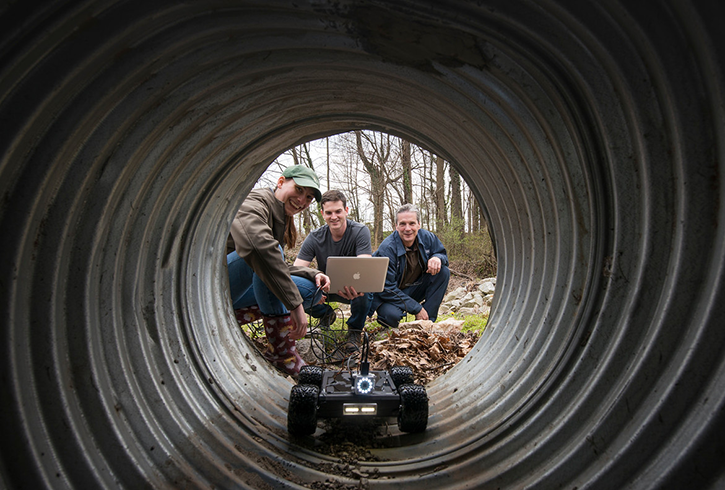
A team of four mechanical engineering seniors designed a robot called Thunder Rat to inspect storm drains on campus. The bot gathers information to help Facilities Management employees pinpoint where they need to make a repair or clean out debris.
He’s a robot doing what a human can’t do.
Kristin Lewis, BS Mechanical Engineering ’18
If a storm drain clogs on campus, it’s Thunder Rat to the rescue.
The custom-made robot goes where no man dares. Armed with a camera, lights and a water-resistant chassis, the bot explores deep dark drains underground looking for leaves, debris, and garbage that block water flow.
“He’s a robot doing what a human can’t do,” says Kristin Lewis, BS Mechanical Engineering ’18.
Lewis and three other seniors in the Mechanical Engineering Department designed the robot for their senior capstone project so that Facilities Management employees could use it to inspect the university’s storm drain system.
The reason: It’s often difficult to pinpoint precisely where drains are clogged, which can lead to costly excavations and disrupt campus activity, Lewis says.
Thunder Rat gives “us a set of eyes that can go underground for an inside view of the quality and condition of the pipes,” says Samira Lloyd, sustainability program manager in the Office of Sustainability, which funded the project through the Patriot Green Fund. “It can save us time and trouble and help our system run better.”
The team, which also calls itself Thunder Rat, faced several challenges in their efforts to design a non-destructive storm drainage inspection system. They had to make sure the robot was water resistant so they filled in lots of cracks and gaps in the chassis.
The students had to find a way to operate the bot because they couldn’t use WiFi underground, so they tethered it to a laptop with a sturdy Ethernet cable, which they also used to pull it out of drains.
Operating the laptop with a game controller, the user can control the onboard computer on Thunder Rat to manipulate the robot’s lights, wheels, and video camera, says Alex Walters, a mechanical engineering senior who graduates this winter.
As Thunder Rat travels through the drain, the robot videos the inspection. If the user detects an issue, he has the robot snap photos. A mechanical wire counter tracks how far the bot travels inside the pipe.
Facilities Management's land development group has already used Thunder Rat to inspect a few pipes on campus, and the videos and photos played an important role in the decision-making process, says the group's manager Zhongyan Xu. "The students were energetic, ambitious, and self-driven. We were impressed not only by their technical skills but also their project management skills."
There are products like Thunder Rat on the market, but they are bigger, more expensive and sometimes it takes a team of people to run them, Lewis says.
“People are selling equipment similar to ours for $10,000 to $40,000,” Walters says. “We spent close to $3,000, so ours is significantly cheaper.”
When the team members turned the robot over to Facilities Management, they provided training as well as a user manual.
“It was great to apply some of the academic concepts that I learned over my four years at Mason and leave some small legacy behind,” Lewis says.
Other team members: Antonio Evans, BS Mechanical Engineering ‘18, Matthew San Nicolas, BS Mechanical Engineering ‘18
